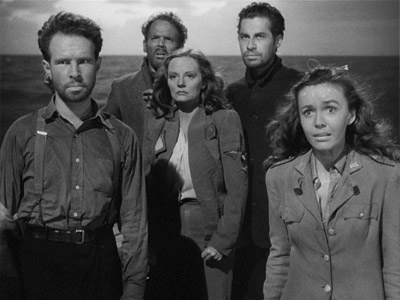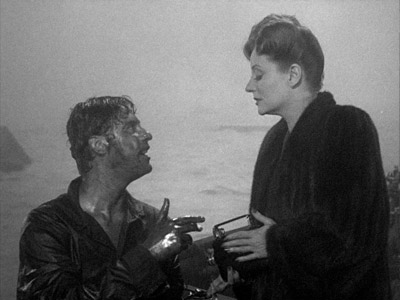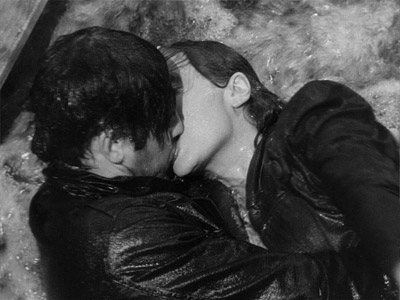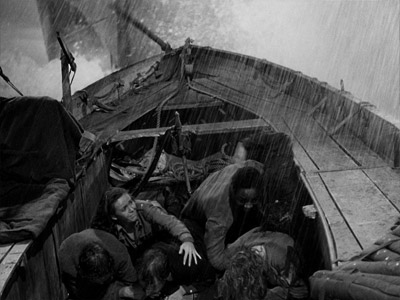"We wanted to show that at that moment there were two world
forces confronting each other, the democracies and the Nazis,
and while the democracies were completely disorganized, all of
the Germans were clearly headed in the same direction." |
Director, Alfred Hitchcock |
Alfred Hitchcock's extraordinary career and body of work is one of a kind. Not only was he poised as a superior craftsman on the cusp of an emerging art form (the 'talkies'), he enjoyed a steady success in his early career leading to an American invitation, one duly accepted and he took full advantage of it. In Hollywood, he enjoyed a period of creativity and fame few directors have ever achieved. And with film-making still in the hands of crews in studios utilising practical, physical effects, experiments and indulgences had to be hard earned not simply to be assigned to the magic of a prolonged digital post-production. It seems inevitable, historically speaking, that Hitchcock would be the great experimenter simply because he had the clout to be so. He was the first mainstream director to make a full feature in one shot (Rope) that artfully hid the joins when one reel ran out and another started. He tried his hand at suspense in 3D with Dial M For Murder. He imprisoned his camera in a single apartment and shot the entire film from one man's perspective (Rear Window) and just for another challenge, he threw a group of diverse characters in a lifeboat of all places and attempted to make a film stuck in one very confined space. Hitchcock thrived on the puzzles inherent in the practicalities of film-making. He has often been characterised as being technically above caring for the actors ("What's my motivation?" "Your pay check.") and monomaniacal in his concern with the minutiae of solving problems.

The cliché has some truth in it but let's acknowledge that there never will be another quite like Hitchcock ever again because technology has made his technical talent outdated and dare I say redundant. I'm not talking about his film-making, just his technical skill. This is in no way to denigrate his myriad achievements that, at the time, were astounding. Today we have become ultra-blasé about anything we see on screen secure in the knowledge that however extraordinary, there's a simple and indifferent shrug of "Oh, it's just CGI..." which is why it's such a lovely shock when you find out that certain things are done practically by traditional effects crafts people. My view is that people overlook Hitchcock's strong sense of characterisation because of the nature of his own desire to invent and reinvent in the genre of his choice, the suspense thriller. My question is simple; how can there be suspense if we don't give a damn about the person who may or may not get blown up? You will not find a greater example of Hitchcockian character strengths than in Lifeboat. Yes, the characters have to be 'types' of a kind (capitalist, fashion journalist, radio operator, nurse, a steward, sailor and an engineer with dreams of equality for all) but in the 95 minutes available to you, you need hooks to hang perceptions on and Hitchcock pulls enough rugs from under us during the running time that makes Lifeboat a compelling study of people under a unique kind of stress.
It's in the middle of the Second World War and a German U-boat has brought down an allied ship. In the battle, the sub was also lost. Survivors gather on to one of the few lifeboats. The last to be picked up is a burly man who utters an ominous work of thanks... in German. And we're off! The star of the show, immaculately turned out despite her dire predicament, is Tallulah Bankhead. Just her wonderful name has enriched my knowledge of Hollywood but here is a great example of her star power attempting to dull all those around her (according to some reports there was a little of this claptrap going on for real on the shoot). She plays a fashion journalist, Connie Porter, complete with cine camera and typewriter to document her experiences. It doesn't take long for her to gradually lose her props and soon she's just as desperate as everyone else. But she has one other significant advantage over everyone with regard to the trustworthiness of the group's new German passenger – she speaks the language.

Assuming captaincy over the rest of the passengers is capitalist Charles Rittenhouse played with an airy superiority by Henry Hull. It's alarming to see how easily the 'lower' ranks are able to accept a stranger taking command by dint of the simple confidence inherent in a man who is used to power and he wears it because of the sickening inevitability of assumed authority. When it's finally questioned why this man has an automatic hold on the survivors' fate, Hull almost makes us feel sorry for his subsequent usurping. But once it's clear that the German is a superior sailor, the rest of the characters are happy, save one, to let him make the decisions. But this is no 'tolerance for the outsider' grand gesture. After all, Hitchcock was offering the allies his support in making this film. The last thing on his mind would be to make the German a good guy. Actor Walter Slezak shows his true colours soon enough.
The characters are the essence of the movie as well they must be as we're stuck on the lifeboat for the entire running time. Connie (Bankhead) is the undoubted star. Her society girl slowly reduced to a dogged survivalist is the lynchpin of the disparate crew. We're invited to see most events through her perspective, one which becomes less and less cultured but more and more human as the film unfolds. Her preferred diamond in the rough is the first man hauled aboard, Kovac (John Hodiak). He's the working man disgusted by Connie's indifference to the suffering she's witnessed but they get up close when things start deteriorating. In fact when they're on the brink of believing they're going to die, Kovac says "We may as well go down together, Connie!" and apart from the sexual allusion (which I have trouble believing was intentional), the resulting kiss is oddly erotic. I can't put my finger on why. I think it's a combination of Bankhead's gusto and a flash of tongue before they clamp lips. I'm just not used to seeing open mouth kissing in black and white movies. It took me by surprise. The other startling event I'll let you stumble into yourselves but if you've seen Paul Newman try to despatch a bad guy in Torn Curtain, you may have an inkling what to expect.

The rest of the group consists of an injured man whose leg has to be amputated (William Bendix) with only a single bottle of brandy as an anaesthetic and a small pocket knife to do the job (yow); a nurse (Mary Anderson as Alice) who's sweet on 'Sparks' played by Hume Cronyn. In my inexperience, I didn't credit Cronyn with a varied and interesting career after seeing him charm the screen in Cocoon. But it seems he was actually one of Hitchcock's friends. And he has the most delicate mouth I've ever seen on an actor. Rounding out the cast are the ill-fated bereaved mother, Heather Angel and Canada Lee playing Joe (the steward who helped the survivors off the stricken boat). When the group act against the German in their midst, Joe is the only one who doesn't join in. In fact he tries to stop them from hurting Willy. Not that I'm accusing Hitchcock of anything like a political statement but it's interesting that the only man who doesn't turn violent at extreme provocation is black. At the movie's start, Connie calls out his nickname as he swims towards the lifeboat, hands full of potential survivors. "It's Charcoal!" she shouts. Oi vey. I'm not sure anyone would get away with that today. To reveal any more of the plot points would be mean spirited of me.
Lifeboat, for its time, features state of the art special effects. Crude today, perhaps, but there is still enough realism in the model work and the back projection that allow you to get involved in the drama. At the start there is a moment when Connie films one of the sailors coming aboard. We get a curious 16mm camera point of view shot, curious in the sense that even when we are supposed to believe the hand held nature of the shot, Hitchcock shoots it rock solid and superimposes (and jiggles) a 16mm frame matte over the image to simulate a hand held motion. It's the equivalent of asking Jamie Oliver to deliberately deflate a soufflé. In fact I cannot recall a hand held Hitchcock shot (experts, feel free to disabuse me). There is a very silly shot of a fish nibbling at the expensive bracelet and the line holding the fish in place is all too obvious. The model work suffers from the same problem that dogs any production featuring the sea. You cannot shrink water and water droplets look like water droplets whether you've shot them in slow motion or not. But Hitchcock's achievement is noteworthy in terms of marrying all the effects together in a very satisfying whole. And there are no matte lines that used to be obvious in later colour productions, an unfortunate side effect of using blue screen in the optical realm.

In a very interesting creative move, Hitchcock chooses to have no music score save over the front and end titles. He uses the 'natural' sound effects to ratchet up the tension. It works disarmingly well given the fact that I didn't even register the lack of a score on my first viewing; and this from a man whose collaboration with composers has yielded some truly brilliant scores.
Lifeboat was one of the very few Hitchcock movies I'd not actually seen before and it was a great pleasure to see it on Blu-ray and know next to nothing about it apart from what I'd read in the Hitchcock/Truffaut book. All in all, a fine work from a film-maker at the height of his powers. There's just one small caveat (see next section).
As Lifeboat was made in 1944, it's fingers crossed for a decent source print. It's presented in the original 1.37:1 aspect ratio (and full marks for showing the correct way to view the film in the back of the accompanying brochure). The number of people who are still content to watch distorted images on their TVs is alarming. Using the restored M as a benchmark, it's slightly disappointing to report that for the first 13 minutes the contrast is very low lending the whole film a greyish tinge and there are significant small circles of damage (water drying marks?) which show up alarmingly over a background of even shade (like the sea at the start). There are tramlines every now and again and also the grain is quite visible if you're really looking for it. The drying marks are most visible at about 9 minutes 52 seconds as brandy is offered to Smith as an anaesthetic.
Suddenly (in the middle of a shot and the line "Throw the Nazi buzzard overboard!") the contrast corrects itself – it's as if the telecine operator suddenly discovered the contrast was at 0 and then chose (at 13 minutes and 6 seconds) to turn it to the correct setting. I'd understand if the change was from one reel to another but it's not. Bizarre. With a more marked contrast, a lot of the water/drying marks disappear. At 16 minutes, 24 seconds, we mix to a twilight scene on the boat which means that the contrast goes up once more. What gives away the back projection of course, is the fact that it looks slightly lighter in tone to the foreground action as it should obeying the laws of physics but reality has perspective whereas the background is clearly a 2D screen. But none of these mild criticisms damages the dramatic heart of the movie in any way. I suppose M spoiled us all. There are optional English subtitles on all three films (two shorts feature in the Extras). The original mono soundtrack is faithfully reproduced in its DTS HD Master soundtrack. Yes, there's some hiss but nothing to complain about.
Hitchcock's French-language 1944 wartime films:
Bon Voyage (26' 00") & Aventure Malgache (31' 00")
These two shorts curiously don't pop up all that often in researching Hitchcock's oeuvre. They merit a footnote of sorts in the Hitchcock/Truffaut book (see later Extra). They are both propaganda films designed to strengthen resistance against the occupying German forces in France and as such do their jobs with little fuss. Two essays (one on each film) appear in the accompanying booklet, pieces invaluable for a finer appreciation of both shorts. There are a few 'moments' that may betray their director's identity (there is a murder at the end of Bon Voyage which is a shock and it's accompanied by a directorial flourish that brings Hitch to mind). Both are relatively wordy (rare examples going against Hitch's dictum that a good film should be able to lose the sound and make perfect sense. I tried watching without the subtitles and I hadn't a clue what was going on). And in Aventure Malgache there is a man wearing a pair of shorts that are so voluminous, you could hold a circus inside them. I say that in passing. I don't think it had any relevance to the plot.

Alfred Hitchcock's Lifeboat: The Theatre Of War (19' 58")
With the principal participation of Hitchcock's daughter, Pat Hitchcock O'Connell, Hitch expert from U.S.C., Drew Caspar (love the hair) and Steinbeck authority, Robert Demott, editor of the Library of America, the context of the making of Lifeboat is revealed. Both John Steinbeck and Hitchcock wanted to display their support for the allies and the great author of Of Mice And Men and Grapes Of Wrath wrote a novella at Hitchcock's request. Told from one survivor's point of view, the novella was much more politically themed (this fits as the FBI had a file on Steinbeck, noting him as a radical. We can't have that, can we?). Hitchcock commissioned a screenplay that departed from the original novella but not enough so that Steinbeck's name couldn't be paraded on posters and in the front of house. In fact it's proudly boasted on the cover of this very Blu-ray. The film's critical reaction was certainly not a unanimous rave but the movie has stood the test of time admirably.
Excerpt from the 1962 interviews between Hitchcock and François Truffaut, discussing Lifeboat and the wartime shorts (audio only) (12'00")
Most movie fans possess copies of the great Hitchcock/Truffaut book, a sort of "How did they do that?" but spanning a career. Truffaut, clearly the student, would go on to a great career of his own. Hitch is also in his element holding court like a Sultan while he reveals his secrets. Praise must go to the translator Helen Scott who greased the communication wheels well enough. Looking up in the book to see the if the reality matched the written word, I was quite surprised to find the recordings had gone through significant editing before being committed to paper.
The 36-page booklet featuring stills and new writing by critics Bill Krohn,
Arthur Mas, and Martial Pisa
As ever, the booklet is a little treasure in and of itself with superb academic essays on all three films on the disc. Almost all of the stills have been printed at 90 degrees to the text. This isn't a problem (I am physically capable of turning the booklet 90 degrees) but it is a departure from the usual as far as I can remember having reviewed a few of Eureka's Masters Of Cinema range.
Lifeboat is a solid entry in the Hitchcock canon. Not as showy as some of his more famous works but a technical tour de force even if the effects cannot stand up to modern scrutiny. It's another fine release from Masters Of Cinema marred only by the dirtiness of the print throughout the first 13 minutes. As this hardly hinders the enjoyment of a damn good yarn, this disc still comes recommended.
|